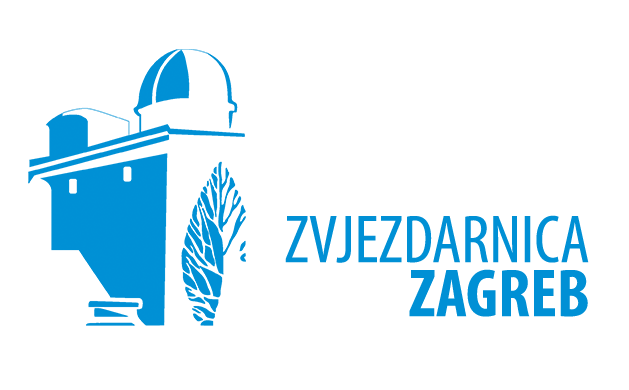NOTE: The calendar above is supplied for information purposes only.
How to reach us?
Frequently asked questions
► Promatraju li se Perzeidi (suze svetog Lovre) na Zvjezdarnici?
Za promatranje Perzeida ne koriste se teleskopi i dvogledi (Opservatoriji u gradovima nisu prikladna mjesta za promatranje meteorskih rojeva). Korištenjem teleskopa ili dvogleda smanjuje se vidno polje, a za promatranje Perzeida potrebno je vizualno obuhvatiti što veći dio neba kako biste mogli vidjeti što veći broj meteora.
Perzeidi se promatraju golim okom na tamnim područjima, daleko od svjetlosnog onečišćenja gradova.
Za amaterska opažanja upravo su interesantni meteoridski potoci, čije staze Zemlja svake godine siječe u isto vrijeme, pa se unaprijed zna vrijeme za njihovo opažanje. Zbog perspektive, meteori potoka prividno izlaze iz jedne točke nebeske sfere (naime, meteoridi pripadaju jednoj skupini i gibaju se paralelno), koja se naziva radijant.
► Što je i kako promatrati “poravnavanje” planeta?
U medijima povremeno možemo pročitati najave da će se planeti “poravnati” nekog određenog datuma. Pri tome se zaboravlja na činjenicu da se planeti prividno cijelo vrijeme nalaze u približno istoj ravnini, odnosno da leže na istom pravcu, da se njihovi međusobni položaji sporo mijenjaju (pa “trenutak” može trajati danima) i da su cijelo vrijeme “poravnani”. Stoga se vjerojatno misli na konjunkciju više planeta, odnosno događaj kada se oni prividno nađu relativno blizu. Problem kod uočavanja takvih konjunkcija je da golim okom u prosječnim uvjetima vidljivosti možemo vidjeti maksimalno 5 planeta (Merkur, Veneru, Mars, Jupiter i Saturn, dok je Uran na granici vidljivosti golim okom), što znači da takve konjunkcije nisu česte. Pojam gore navedenog poravnavanja može se proširiti na događaj kada je tijekom noći iznad obzora istovremeno više sjajnih planeta i kada je bez problema moguće pratiti ravninu ekliptike uzduž koje su planeti raspoređeni. Za samo promatranje “poravnavanja” nije potrebna nikakva astronomska oprema. Dovoljno je naći neku lokaciju s koje je vidljiv veći dio nebeske sfere (prvenstveno južni dio od istoka do zapada) i uživati u pogledu. Dodatno, ako pri ruci imate teleskop onda ga možete iskoristiti kako biste upotpunili doživljaj.
► Do kuda se pruža vidljivi horizont i zabluda ravne Zemlje?
Daljina vidljiva horizonta ovisi o visini na kojoj je motritelj i Zemljinoj zaobljenosti. Kada ne uzimamo u obzir Zemljinu atmosferu, njen iznos u kilometrima možemo izračunati tako da drugi korijen iz nadmorske visine motritelja (u metrima) pomnožimo s 3,57. Primjerice gledano s nadmorske visine 1000 m ona iznosi oko 113 km. Međutim, u stvarnosti ona može biti drastično veća. Razlog je promjenjivo fizičko stanje prizemnih atmosferskih slojeva u kojima staze svjetlosnih zraka zbog refrakcije (loma) imaju vrlo nepravilan oblik. Poseban je slučaj pri temperaturnoj inverziji (temperatura raste s visinom). Uz odgovarajući iznos temperaturnog gradijenta u atmosferi polumjer zakrivljenosti refraktiranih (prelomljenih) zraka može biti približno jednak Zemljinu polumjeru. U tom slučaju staze svjetlosnih zraka prate zakrivljenu Zemljinu površinu na putu od više stotina kilometara i moguće je i s male nadmorske visine (primjerice s brodske palube) vidjeti jako udaljene predmete. Ako se temperaturna inverzija ustabili na većem području (što je osobito u polarnim krajevima), ovaj učinak može značajno utjecati na vrijeme izlaska i zalaska Sunca. Prvi put to su uočili istraživači pod vodstvom Willema Barentsza krajem 16. stoljeća na polarnom području Rusije (Novaja Zemlja). Primijetili su da se Sunce vidi nad horizontom iako je prema astronomskim izračunima trebalo biti više od 2° ispod horizonta. Slične slučajeve su zabilježili i mnogi drugi pomorci, a nije čudo da recimo se iz Italije ponekad mogu vidjeti priobalna mjesta u Hrvatskoj. Neki znanstvenici smatraju da je temperaturna inverzija mogla biti razlogom tragedije Titanica, koji je nakon sudara sa santom leda potonuo u vedroj i hladnoj noći 15. travnja 1912. Zbog temperaturne inverzije daleki horizont prividno je uzdignut i puno je teže na takvoj pozadini uočiti santu leda. Lakše ju je uočiti kada je u pozadini vedro nebo i kada ona sakriva pogled prema dijelu neba na kojem tada ne vidimo zvijezde.
Nepoznavanje ili prešućivanje ove pojave zagovornici ravne Zemlje navode kao dokaz da Zemlja nije okrugla, jer bi tobože bilo nemoguće vidjeti tako udaljene predmete na zaobljenoj Zemljinoj površini. Da Zemlja nema atmosferu (recimo kao što je to slučaju kod Mjeseca) brzo bi se razuvjerili u te tvrdnje.
Na kraju spomenimo da je arapski astronom al-Biruni, eksperimentalnim mjerenjima vezanim uz daljinu vidljiva horizonta, još prije tisuću godina vrlo točno odredio iznos Zemljina polumjera. “Pogriješio” je za svega desetak kilometara.
► U večernjim satima vidim “zvjezdice” koje se preko nebeskog svoda kreću jedna za drugom. O čemu je riječ?
U zadnje vrijeme sve je više upita građana vezano uz navedenu pojavu. Riječ je o satelitima iz serije Starlink tvrtke SpaceX kojih je do travnja 2020. g. lansirano nešto manje od 400. Više o satelitima možete naći na mrežnim stranicama upisom pojma “Starlink”. Trenutke njihove vidljivosti iznad nekog područja možete naći primjerice na: https://www.satflare.com/track.asp?q=starlink ili https://www.heavens-above.com/.
► Može li se posjetiti Zvjezdarnica radi opažanja neba i kada?
Posjeti Zvjezdarnici radi opažanja neba su mogući. Opažanje je moguće samo u slučaju vedrog vremena. Prostorije Zvjezdarnice nalaze se na zadnjoj etaži (treći kat) kompleksa zgrada u Opatičkoj 22. Za pojedinačne posjete građana ili manjih grupa (npr. obitelji i sl.) ulaz je besplatan i nije potrebna prethodna najava. Aktualne informacije o radnom vremenu možete naći na poveznici radno vrijeme, ili u zaglavlju ove stranice.
► Koja se nebeska tijela opažaju sa Zvjezdarnice u terminu za posjete građana?
Glavnim teleskopom pod kupolom Zvjezdarnice posjetitelji uglavnom opažaju sjajnija nebeska tijela, poput Mjeseca, planeta i ponekih maglica. Mjesec je najbolje opažati u danima oko faze prve četvrti, kada ga vidimo u obliku srpa. Zbog vlastitog gibanja i gibanja Zemlje, planeti mijenjaju svoj položaj na zvjezdanom nebu, pa su pogodni za opažanje samo u određenim razdobljima. Od planeta najzanimljiviji su Jupiter sa svojim mjesecima i Saturn s lijepo vidljivim prstenom. Izgled noćnog neba, odnosno vidljivost pojedinih zviježđa, mijenja se tijekom godine. Tako primjerice Orionovu maglicu opažamo tijekom zime, Andromedinu galaktiku tijekom jeseni, dok prstenastu maglicu (M51) i kuglasti skup M13 možemo vidjeti tijekom ljeta i rane jeseni.
Povodom posebno atraktivnih astronomskih pojava (poput pomrčina, pojave kometa i sl.) organizira se posebni program opažanja.
Zvjezdarnica ne organizira promatranja meteora (Perzeidi – Suze svetog Lovre, Leonidi, Orionidi …) jer je njih najbolje opažati golim okom s lokacija koje nisu svjetlosno onečišćene, kao ni u medijima razvikane “jedinstvene događaje” poput “poravnavanja planeta”, supermjeseca i sl.
► Kako najaviti posjet školske grupe (ili druge organizirane skupine) Zvjezdarnici?
Školske (i druge) grupe primaju se uz prethodnu najavu (telefonski na broj 01/4851-355 ili e-mailom (info@zvjezdarnica.hr), radi dogovora i rezervacije termina. Uobičajeno se održi prikladno predavanje i upriliči razgledavanje Zvjezdarnice i astronomske opreme te opažanje teleskopom u slučaju vedrog vremena.
► Gdje mogu pronaći podatke o vremenima izlaska i zalaska Sunca za bilo koje mjesto poznatih geografskih koordinata?
Podatke o izlascima i zalascima Sunca sa zadovoljavajućom točnošću možete naći na stranici https://izlazak-zalazak-sunca.com/. Alternativno, podatke o izlascima i zalascima Sunca također možete naći na stranici https://hr.meteocast.net/ gdje nakon odabira naselja pri dnu stranice kliknete na “izlazak i zalazak sunca u …”, ili na nekom od inozemnih servisa poput Time and Date (timeanddate.com) i sl.
► Kako mogu kupiti (imenovati) zvijezdu?
Nažalost zvijezdu nije moguće kupiti (niti imenovati po svojoj želji) premda postoje internetske stranice koje se bave tobožnjom “prodajom” zvijezda. Imenovanje nebeskih tijela je u nadležnosti Međunarodnog astronomskog saveza (https://www.iau.org/), krovne svjetske astronomske organizacije koja na svojim stranicama (http://www.iau.org/public/buying_star_names/) daje detaljnije informacije o toj problematici.
► Gdje se mogu pronaći informacije o natjecanjima iz astronomije za učenike?
Natjecanja od 2009. godine provodi AZOO tako da sve informacije o uvjetima i terminima treba potražiti na njihovim stranicama http://astronomija.azoo.hr/ i http://www.azoo.hr/. Natjecanja se provode na 3 razine (školska, županijska i državna), a za županijska natjecanja potrebno izraditi praktični rad (1-2 učenika po radu).
Arhiva natjecanja (uključujući testove s rješenjima) od 2001. do 2008 godine nalazi se na našoj stranici:https://zvjezdarnica.hr/edukacija/edukacija/natjecanja-iz-astronomije/
► Gdje se može nabaviti literatura iz astronomije pogodna za nastavu u školama i izvannastavne aktivnosti?
Na Zvjezdarnici moguće je nabaviti knjigu Elementarna Astronomija I. dio koja je prkladna za srednjoškolce, pogotovo za kandidate za državno natjecanje i međunarodnu olimpijadu (https://zvjezdarnica.hr/edukacija/izdavastvo/knjige/elementarna-astronomija-1-dio/). Na našoj stranici nalazi se poveznica na web izdanje knjige Astronomija 1 http://www.zvjezdarnica.hr/knjige/Astronomija1.pdf koja je namjenjena fakultativnoj nastavi astronomije u srednjim školama a dio njenog sadržaja pokriva i program za osnovne škole. Izdavačka kuća Element iz Zagreba izdala je udžbenik “Astronomija za učenike osnovne škole” autora V. Vujnovića. Isti autor objavio je dva udžbenika “Astronomija I. i II”. u izdanju Školske knjige koji su prikladniji za srednjoškolce. Školska knjiga je također izdala udžbenik pogodan za početnu nastavu u osnovnim školama i vidljiv je na poveznici: http://www.gimpoz.hr/repos/files/135076265000-udzbenik-sadrzaj.pdf. Uz udžbenike, kao dodatni materijali mogu se koristiti karte, posteri, časopisi (primjerice vidjeti poveznicu: https://zvjezdarnica.hr/edukacija/izdavastvo/), kao i različite internetske izvore.
Opsežni edukacijski prilozi nalaze se na našim stranicama e-škole http://eskola.zvjezdarnica.hr/.
Arhiva natjecanja (uključujući testove s rješenjima) od 2001. do 2008 godine nalazi se na našoj stranici:https://zvjezdarnica.hr/edukacija/edukacija/natjecanja-iz-astronomije/
► Što je supermjesec?
U posljednje vrijeme često se u javnim medijima najavljuje pojava tzv. supermjeseca i to obično senzacionalno, kao da se radi o nekoj iznimnoj astronomskoj pojavi. Pojam supermjesec ne upotrebljavamo u astronomiji. On je prije nekoliko desetljeća uveden u astrologiju i odnosi se položaj Mjeseca u perigeju (ili u blizini perigeja) za faze mlađaka ili uštapa. Pažnju javnosti obično privuče slučaj je za faze uštapa Mjesec u perigeju (ili u blizini perigeja). Tada je Mjesec prividno veći i sjajniji negoli za uštapa koji nastupa u nekoj drugoj točki Mjesečeve staze udaljenijoj od Zemlje. Možda tada i zaslužuje naziv supermjesec. Mjesec je za uštapa u perigeju oko 14% prividno veći i oko 30% sjajniji negoli za uštapa u apogeju. Ipak, pitanje je da li mi možemo prepoznati tu razliku. Najbolje to potvrđuje pojava kada nam se čini da je puni Mjesec nad obzorom veći negoli kada zauzme položaj visoko nad horizontom, premda je u tom slučaju čak udaljeniji (za otprilike veličinu Zemljina polumjera) i u stvarnosti nešto manji. Astronomi i drugi znanstvenici (primjerice psiholozi) još uvijek nisu uspjeli u potpunosti objasniti ovu pojavu.
Učestalost nastupanja punog Mjeseca u perigeju (ili u blizini perigeja) vezana je uz iznose anomalističkog i sinodičkog Mjeseca. Četrnaest sinodičkih mjeseci traje otprilike koliko i 15 anomalističkih mjeseci, što iznosi nešto više od 413 dana. Otprilike u tom razdoblju ponavlja se nastupanje uštapa za perigeja, što kako vidimo i nije tako rijetko. Za uštapa koji se događaja u perigeju (ili u njegovoj blizini) Mjesec nije uvijek jednako udaljen od Zemlje. Odstupanja su relativno mala, puno manja od Zemljina polumjera pa kada uspoređujemo Mjesečevu udaljenost za uštapa u perigeju veći doprinos može imati položaj opažača, odnosno vrijeme opažanja.
Zagreb Observatory

Opatička 22, PP 487
10001 Zagreb
T: +385 1 4851355
F: +385 1 4851355
E: info@zvjezdarnica.hr
Search
Find what interests you.
Did you know?
Copyright © 2006 — 2025 Zagreb Observatory. Web design and support: Stjepan Tafra. Privacy policy.
